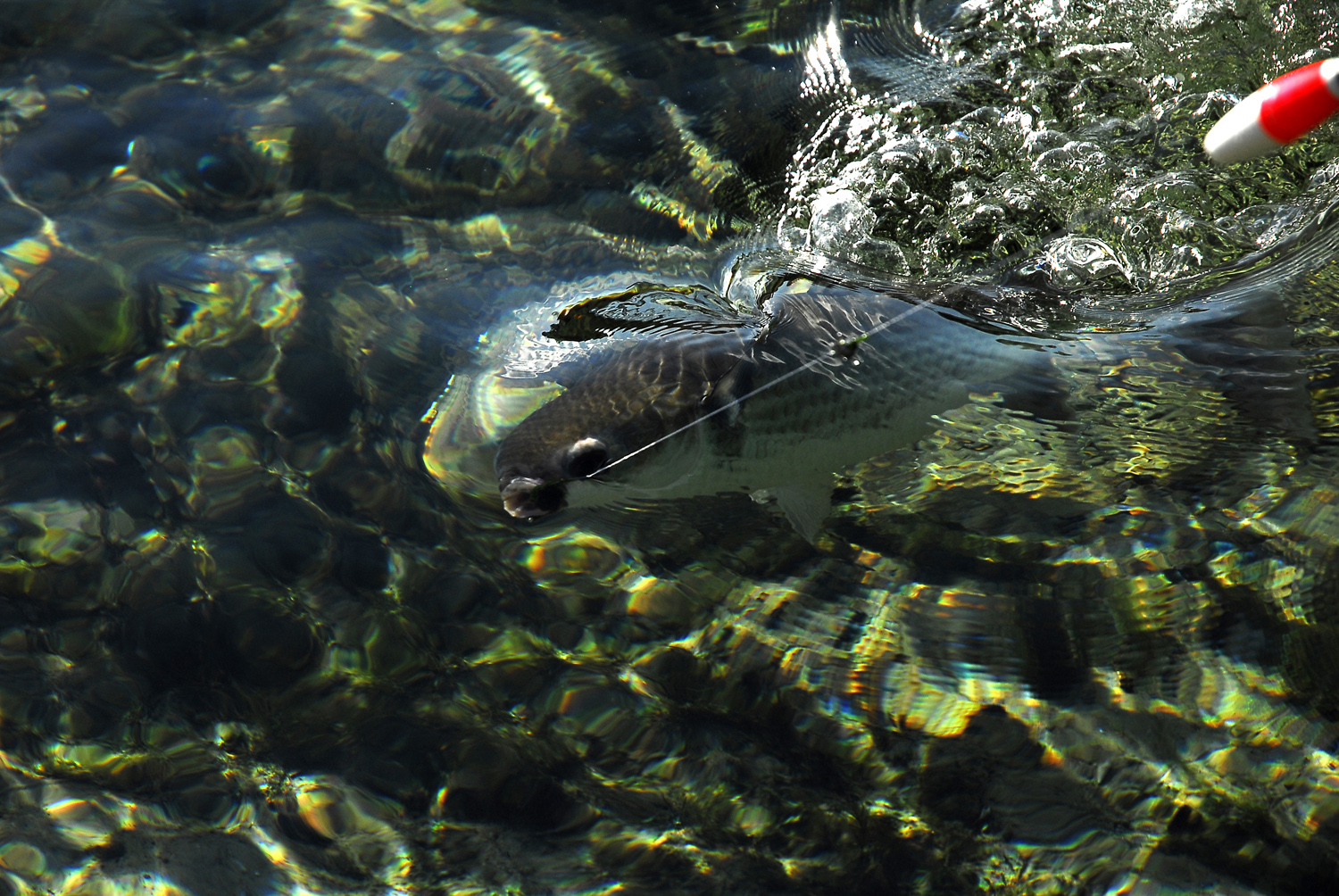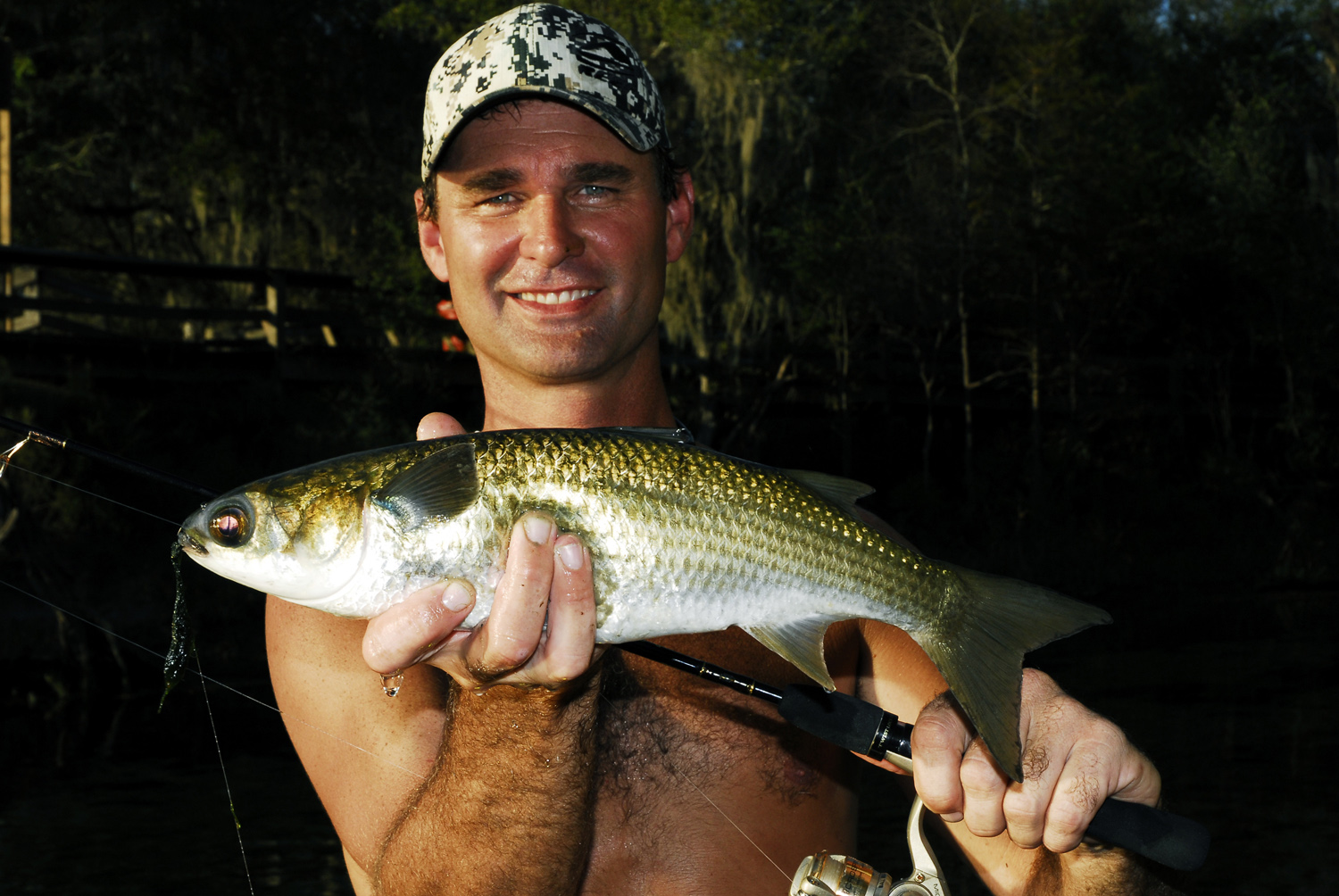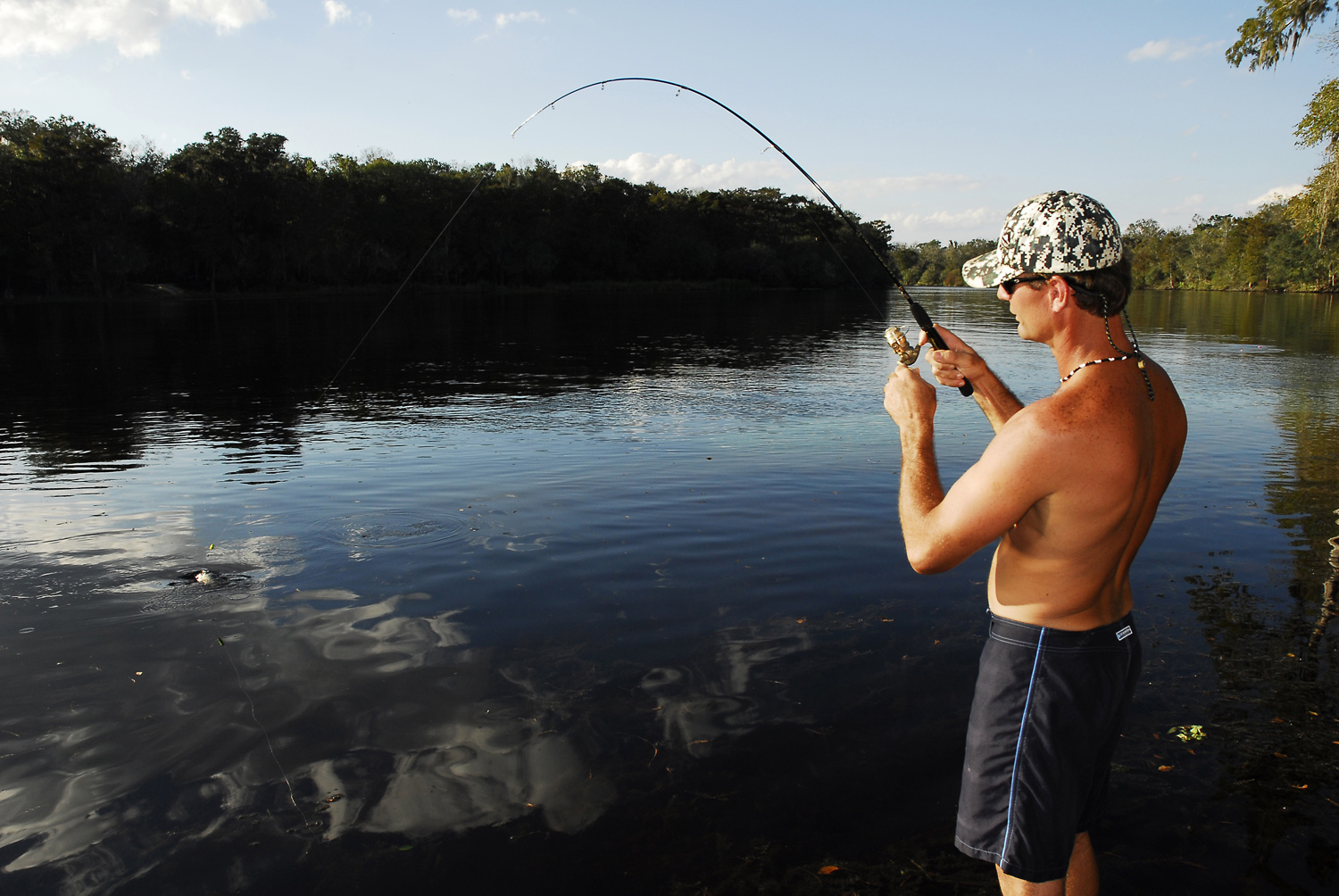August 13, 2015
By Joe Richard, Assistant Editor
And you thought mullet were lowly herbivores.
By Joe Richard
 Gainesville angler Steve Alford catches a striped mullet for keeps.
Gainesville angler Steve Alford catches a striped mullet for keeps.
The mullet fishery is alive and well in Florida, much more so than say, amberjack or grouper—both tales of woe with respect to management and harvest these days. I was reminded of this recently, when a happy angler cranked his boat on the trailer at the St. Johns River and showed me his cooler.
In a pleasant day of fishing around nearby springs, with the wind soaring through the trees, eagles and osprey swooping nearby, he had loaded a sizeable box with silver and striped mullet. Many of the stripes were close to three pounds. He'd caught them on artificials, plastic baits under small corks. His trip—simply motoring a short distance, then anchoring and chumming—was a reminder that it's still possible to keep expenses quite low while loading up on tasty fish. A catch like the one I saw was enough to make some anglers reassess their fishing priorities. His technique is at the bottom of this report.
Next day I heard about this guide, Capt. Gene Zamba in southwest Florida, who has been catching loads of big mullet with 6- and 7-weight fly rods. He creates tiny green flies, the size used on famous trout rivers up North. Way up North. Not Alaska north, but the Madison River in Montana. Tiny mullet flies imitate bits of vegetation that every mullet is keen for. More on these flyfishing techniques below, which originated in England.
In some areas of the world, mullet fishing is taken seriously. England has a National Mullet Club (NMC), for instance, with a nice Web site at www.thenationalmulletclub.org. Their favorite book, Mastering Mullet, is a hot seller. They stress conservation and release-only, since mullet feed on coastal nutrients that in England, at least, are not considered safe. Slow-growing in a cooler climate, a 10-year-old striped mullet there has probably accumulated toxins.
 Small float, splitshot and tiny hook can be baited with tidbits resembling whatever chum you opt to use.
Small float, splitshot and tiny hook can be baited with tidbits resembling whatever chum you opt to use.
Florida and its freshwater springs obviously are the polar opposite, with bottling companies jostling for freshwater springs in north Florida. Mullet from there, including many spring-fed rivers like the Suwannee, are considered safe and tasty, maybe the best in the world. They're also plentiful.
Another guide who uses flies along the Big Bend is Capt. Ken Roy in Crystal River. He ties his own Woolly Worm flies in white. He rigs them in tandem like a sabiki rig, up to five per leader, and sets them under a small float, using a strong cane pole. The lowest Woolly on the ladder gets a lead splitshot weight, to keep the string of flies vertical. For those without tiny files, look no farther than your local tackle store. Very small sabiki flies might work as well, using green as a starting color. They should be suspended under a tiny float and fished quietly after chumming with bread crumbs. You can't horse a big mullet on a hair hook, however, so keep the reel's drag fairly loose.
Mullet won't always feed at middepth. Florida anglers often notice schooling mullet apparently “gulping air,” but dedicated mullet fans in England believe they're actually feeding on tiny phytoplankton from the neuston layer, which is the top few centimeters of water. They're skimming the surface film, which are slicks that form on calm days or in sheltered water protected from the breeze, such as the downwind side of a jetty. The Brits say these gulping mullet aren't interested in a baited hook; they're feeding on something far too small to see.
And of course mullet feed on the bottom, slurping algae right off grass and substrate.
So how are mullet stocks doing in Florida? Not bad, according to Dr. Behzad Mahmoudi, chief mullet researcher at the Florida Fish and Wildlife Research Institute (FWRI) in St. Petersburg. He says not to worry.
“Current findings and the observed high SPR estimates support the general conclusion that while there is uncertainty about the model output, the best estimates for the transitional spawning potential ratios in each region likely exceed the 35 percent SPR target,” said Mahmoudi. “This seems to indicate that current levels of fishing effort are sustainable. Commercial landings levels in the past 10 years and market conditions suggest that landings have stabilized at about 1.3 million pounds on the east coast, 1.8 million pounds on the northwest coast, and 5.2 million pounds on the southwest coast. At these recent landings levels, fishing mortality rates should stabilize or decline further, if growth of mullet stocks continue at the present rate.”
According to Mahmoudi, for the years between 1985 and 1993 Florida's commercial catch averaged 22 to 23 million pounds, statewide. In 1994, just prior to the net ban, it dropped to 15 million pounds because of a closure on netting during weekends. In 1995, the year of the net ban, landings dropped to 5.6 million pounds. And a repeat, the following year. In 1997 it rebounded to 8.5 million. It's been between 8 and 9 million pounds ever since.
“They're mostly caught by commercial castnets,” says Mahmoudi. “Some seine operations continue in northwest Florida, but the nets can't be bigger than 500 square feet.”
 Light spinning tackle makes for a fulfilling fight.
Light spinning tackle makes for a fulfilling fight.
Interestingly, the price of mullet roe hasn't climbed much. Supply from Florida has dropped 60 percent from prior to the net ban. However, other factors have changed. North Carolina, Alabama and Louisiana now provide roe. When it peaked years ago, a 3- or 4-pound mullet full of red roe was worth $8 to $9. That was $2.25 a pound. Today roe is worth $1.60 or $1.70 at the peak of the season. Implementation of Florida's net ban coincided with a recession in the southeast Asian economy. People cut back on luxury items. Their economy has bounced back to some extent, but there is a lot of mullet production from other parts of the world. Especially aquaculture. Taiwan and some Mediterranean and African countries are exporting roe. That's a wide area. Striped mullet is pretty much a worldwide species stretching from 40 degrees north to 40 degrees south latitude. Many countries can produce mullet, but they're not as highly regarded as Florida mullet—because ours just taste better.
A combination of economic demand and production in other countries has kept the price of roe down. But the price of summer mullet for food fish has climbed in Florida, from around 25 cents up to perhaps 80 cents. So they're more valuable as a food fish here than ever before. It sounds like one can just about make a living, canepole fishing for mullet, if they have a food products license. There are more stressful ways to pay the bills these days, rather than sitting on the shore with a cane pole.
“The mullet life cycle is one of the most fascinating species,” Mahmoudi says. “During the spawning season from November through January, they school up before spawning offshore. They move offshore with the passage of a cold front. The dropping barometric pressure change affects the mullet as the norther nears, and they school up. When the cold front hits, they move offshore with the outgoing tide, often at night. They use that to reduce predation from gamefish.
“With silver mullet, when they spawn in winter, we believe the eggs get into the Gulf Stream,” he says. “They're transported north and may settle in the Carolinas, growing all the time. They settle in the bayous and estuaries and grow until the following September and October. As water temps drop there, they migrate south along the beach, massive schools of fingerlings. And then they settle in the St. Johns River and Indian River, along there, and spend the rest of their lives in Florida. Interestingly, they have never found silver mullet bigger than 9 months old in North Carolina. We believe they all leave and migrate to Florida.
“Because these fish are herbivores, they really clean the system and convert it to fish protein—food for other predators. That's a very important role.”
Chumming Mullet
For a box full of tasty mullet, buy a sack or two of chum. Not the usual kind, but 50-pound bags of Poultry Grower Finisher 15 percent in pellets only, according to veteran mullet-snatchers. Once the boat is anchored, mix a handful of chum firmly with water into the size of a baseball. Wind up like Nolan Ryan and pitch it a good ways out, far enough where the mullet won't know your boat is anchored nearby.
Next, rig up four or five No. 2 hooks under a very small cork. A small weight will keep the hooks in line, but won't submerge the float. Then, using a white plastic earthworm, bite off the thinnest sliver you can. Thread a piece on each hook. The effect underwater must look like a string of chum descending. Multiple spinning rods are set out, and the corks closely watched. Add more chum. When a cork suddenly lays on its side or disappears, grab the rod and tighten the line. It works on both mullet species, with the bigger stripes putting up a good fight.
Originally published in Florida Sportsman magazine, December 2009 print edition
Click Here to Have Florida Sportsman Magazine Delivered to Your Door.
